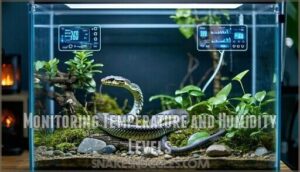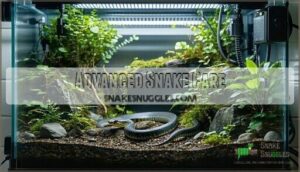This site is supported by our readers. We may earn a commission, at no cost to you, if you purchase through links.
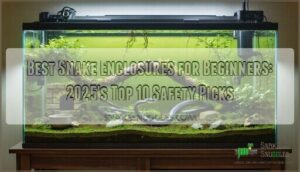
PVC enclosures excel because they’re lightweight, simple to clean, and maintain humidity effectively – essential for your snake’s health.
Glass terrariums with screen tops often struggle with humidity retention and can be surprisingly heavy to move.
Wooden enclosures, while attractive, are porous and difficult to sanitize properly.
Start with a 40-gallon long tank for most beginner-friendly species like ball pythons or corn snakes.
Focus on secure latching mechanisms, adequate ventilation, and easy access for cleaning.
The right enclosure becomes your snake’s safe haven and your peace of mind.
Table Of Contents
- Key Takeaways
- Choosing Snake Enclosures
- Top 10 Snake Enclosures
- 1. Zoo Med Reptihabitat 20 Long Snake Starter Kit
- 2. Exo Terra Terrarium Cabinet Medium
- 3. Exo Terra Reptile Terrarium Large
- 4. Refrigerator Door Lock for Adults
- 5. Child Proof Refrigerator Locks Set
- 6. Reptile Enclosure Cage for Snakes
- 7. Reptile and Snake Terrarium Box
- 8. Large Reptile Enclosure Habitat Tank
- 9. Reptile Feeding Box Terrarium Cage
- 10. Reptile Breeding Tank Enclosure Cage
- Setting Up Enclosures
- Maintaining Healthy Enclosures
- Advanced Snake Care
- Frequently Asked Questions (FAQs)
- What type of enclosure is best for snakes?
- Do snakes prefer small enclosures?
- What not to put in a snake enclosure?
- How do you make a snake enclosure more comfortable?
- Do you need a snake enclosure?
- What is a DIY snake cage enclosure?
- How do you make a snake enclosure?
- What kind of enclosure does a beginner snake need?
- What is the best snake for a first time owner?
- What is the best habitat for a pet snake?
- Conclusion
Key Takeaways
- Choose PVC or glass terrariums over wood – You will get better humidity control and easier sanitization with these materials, while wooden enclosures absorb moisture and harbor bacteria.
- Start with a 40-gallon long tank minimum – You will accommodate most beginner species, like ball pythons and corn snakes, comfortably without needing frequent upgrades as they grow.
- Prioritize secure latching mechanisms – You will prevent dangerous escapes by investing in enclosures with reliable locks, as 68% of new owners abandon their pets due to housing failures.
- Focus on proper environmental control features – You will need built-in ventilation, cable ports for heating equipment, and dual access doors to maintain the temperature gradients and humidity levels essential for your snake’s health.
Choosing Snake Enclosures
You’re about to choose your first snake’s home, and selecting the right enclosure directly impacts your reptile’s health and your success as a keeper.
Your snake’s home isn’t just a container—it’s the foundation of their lifelong health and happiness.
The materials, size, and features you pick now will determine how easily you’ll maintain proper temperature gradients and humidity levels for years to come, which is crucial for your snake’s well-being and your success as a keeper.
Factors to Consider for Beginners
When choosing snake enclosures, you’ll need to take into account several key factors that directly impact your pet’s health and your success as a keeper.
Snake species requirements vary substantially, so research your specific snake’s adult size, habitat preferences, and behavioral needs before purchasing.
Budget considerations include initial setup costs and ongoing maintenance expenses, while space availability in your home determines enclosure dimensions.
Essential safety features like secure locking mechanisms prevent escapes, and understanding maintenance needs helps you select beginner snake tanks that match your cleaning schedule and experience level, considering your initial setup costs.
Researching Snake Behavior and Temperament
Different snake species show distinct behavioral patterns that directly impact your enclosure choice.
Your snake’s personality will shape everything from hiding spots to feeding routines—match the enclosure to the temperament.
Understanding snake temperament helps you select appropriate beginner snake tanks that match each species’ specific needs.
Key behavioral factors to research:
- Species differences – Corn snakes remain calm during handling, while ball pythons prefer minimal interaction
- Stress indicators – Watch for defensive posturing, excessive hiding, or feeding refusal in new environments
- Activity patterns – Arboreal species need vertical space, while terrestrial snakes require horizontal room for movement
Proper behavioral enrichment depends on matching your snake enclosures to natural habits, ensuring successful pet snake care.
Setting Up a Suitable Environment
Your snake’s success depends on creating the right foundation from day one.
You’ll need proper substrate selection, temperature gradient zones, and humidity control systems working together seamlessly.
| Environment Factor | Beginner Requirements |
|---|---|
| Substrate & Hiding Spots | Aspen shavings, 2+ secure hides |
| Temperature & Lighting | 75-88°F gradient, UVB optional |
| Humidity & Ventilation | 50-60%, proper airflow balance |
Snake habitat ideas should prioritize your pet’s natural behaviors while making reptile enclosures manageable for beginner snake care.
Top 10 Snake Enclosures
You’ll find these ten enclosures offer proven safety features and beginner-friendly designs that simplify your snake’s care routine.
Each option balances security, ventilation, and accessibility to help you create the perfect habitat for your new reptile companion.
1. Zoo Med Reptihabitat 20 Long Snake Starter Kit
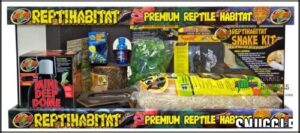
This complete kit eliminates guesswork for first-time snake owners by including everything needed for proper setup.
The 20-gallon terrarium accommodates most beginner species like corn snakes and ball pythons up to 4.5 feet long.
You’ll get essential components including substrate, heating elements, water dish, and hiding spots.
While the analog thermometer and basic heater work adequately, you might want digital upgrades later for precise temperature control, considering the overall complete kit.
Best For: First-time snake owners looking for a complete starter setup that accommodates beginner species like corn snakes, ball pythons, and king snakes up to 4.5 feet long.
- Frequent shipping damage reports due to inadequate packaging, with many customers receiving broken glass tanks
- Basic analog thermometer and heating equipment may require upgrades for species needing precise temperature control
- Sand substrate included poses impaction risks and should be replaced with safer alternatives like aspen bedding
- Complete all-in-one kit eliminates guesswork with essential components including terrarium, heating, substrate, hiding spots, and care guide
- Suitable size for most hatchling and juvenile snakes, lasting approximately 2 years for common beginner species
- Secure sliding screen top provides proper ventilation while preventing escapes during feeding and cleaning
2. Exo Terra Terrarium Cabinet Medium
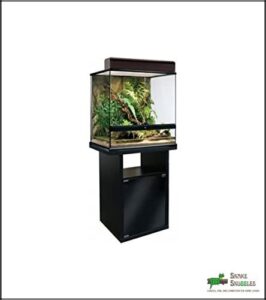
Everyone deserves a reliable foundation when housing their first snake, and this cabinet delivers exactly that.
The Exo Terra Terrarium Cabinet Medium combines FSC-certified construction with contemporary black styling and smoked tempered glass doors.
You’ll appreciate the integrated storage compartment that keeps feeding supplies and cleaning equipment organized below your terrarium.
The external display shelf provides convenient access to frequently used items while maintaining a clean aesthetic.
Magnetic latches guarantee secure closure, while the sturdy design supports medium-sized terrariums safely for years of reliable use.
Best For: Snake enthusiasts seeking a professional, organized setup that combines secure terrarium storage with contemporary home décor styling.
- Assembly instructions are often unclear and may require significant time investment (15 minutes to 1 hour)
- Constructed from pressboard rather than solid wood, with some plywood components prone to cracking
- Higher price point than expected, with some users suggesting $70 would be more appropriate value
- FSC-certified construction with tempered glass doors ensures environmental responsibility and safety
- Integrated storage compartment keeps feeding supplies and cleaning equipment neatly organized below the terrarium
- Magnetic latches and sturdy design provide secure closure while supporting medium-sized terrariums reliably
3. Exo Terra Reptile Terrarium Large
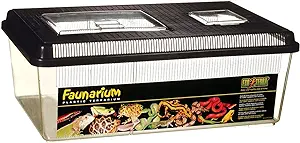
Third-ranked among professional terrarium choices, this large Exo Terra model delivers serious space for growing snakes.
You’ll appreciate the 36×18×18 inch dimensions that accommodate ball pythons and corn snakes comfortably.
The tempered glass construction withstands daily handling, while dual front doors make feeding and cleaning straightforward.
Built-in ventilation prevents humidity issues that plague cheaper alternatives.
At 4.7/5 user ratings, it’s proven reliable for beginners who want room to grow, with a design that has made it a serious space for snake owners.
Best For: Beginner snake owners who need a reliable, long-term terrarium with professional-grade features and ample space for medium to large species.
- Heavy at 35 pounds when empty, making relocation and initial setup challenging
- Higher price point compared to basic plastic alternatives
- Large footprint requires significant space and may not fit smaller setups
- Spacious 36×18×18 inch dimensions accommodate ball pythons, corn snakes, and other medium-large species comfortably
- Tempered glass construction with dual front doors provides durability and easy access for feeding and maintenance
- Excellent ventilation system with front vents and mesh top prevents humidity issues while supporting proper airflow
4. Refrigerator Door Lock for Adults
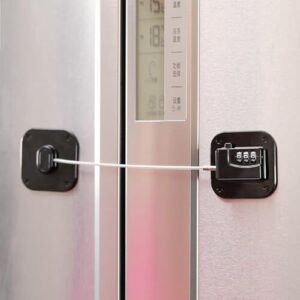
When securing your snake’s enclosure becomes critical, repurposing refrigerator door locks offers an ingenious solution that many experienced keepers swear by.
These affordable locks install without permanent drilling on sliding glass doors, preventing escape-prone species from pushing open enclosures.
You’ll appreciate the adult-only access feature that keeps children and unauthorized individuals from accidentally releasing your snake.
The adhesive mounting allows repositioning without damaging expensive glass terrariums, while the simple groove design accommodates most sliding door overlaps effectively, providing a secure and reliable way to keep your snake safe.
Best For: Snake keepers who need affordable, damage-free security solutions for sliding glass enclosure doors to prevent escapes.
- No drilling required – adhesive mounting won’t damage expensive glass terrariums
- Adult-only access prevents children from accidentally opening enclosures
- Repositionable design allows transfer between different enclosures as needs change
- Adhesive strength may fail over time, especially with powerful snake species
- Instructions often in Chinese, requiring QR code access for combination changes
- Not suitable for high-security needs due to reliance on adhesive mounting
5. Child Proof Refrigerator Locks Set
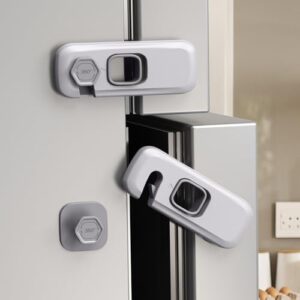
Protecting your snake from accidental escapes requires multiple layers of security beyond the primary enclosure.
Child proof refrigerator locks provide an additional safety barrier that prevents curious children or pets from opening terrariums unexpectedly.
These durable ABS plastic locks use adhesive installation, eliminating drilling needs while maintaining strong hold under stress.
You’ll appreciate the dual-button mechanism that requires simultaneous pressing, making adult access quick but child bypassing nearly impossible.
The locks accommodate various door sizes and withstand over 100 pounds of pulling force, ensuring your snake stays secure.
Best For: Pet owners with children, people with special needs, or anyone needing secure barriers to prevent unauthorized access to snake enclosures and other sensitive areas.
- Dual-button mechanism requires simultaneous pressing, making it nearly impossible for children to bypass while allowing quick adult access
- Strong adhesive installation eliminates drilling needs and withstands over 100 pounds of pulling force
- Universal compatibility works on various door sizes and surfaces including stainless steel, glass, and plastic
- Adhesive requires 12-24 hours to reach full strength, delaying immediate use after installation
- Some users report receiving fewer locks than advertised in their packages
- Removal may leave adhesive residue that requires cleaning with fishing line or solvents
6. Reptile Enclosure Cage for Snakes
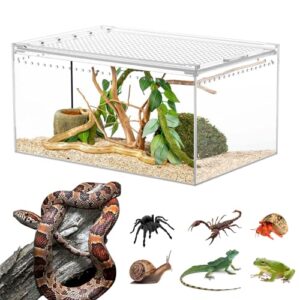
This acrylic enclosure offers crystal-clear visibility and magnetic closure convenience for your snake.
You’ll appreciate the no-assembly design that’s ready to use straight from the box.
The 12"x8"x6" dimensions work well for juveniles and smaller species like corn snakes or young ball pythons.
However, you’ll need to upgrade as your snake grows, since this compact size won’t accommodate adults long-term.
When designing a snake enclosure, consider the importance of proper ventilation systems to guarantee a healthy environment for your pet.
Best For: Snake keepers with juveniles or smaller species like young ball pythons and corn snakes who need a clear-view, ready-to-use enclosure for temporary housing.
- Small 12"x8"x6" size requires upgrading as snakes grow, making it unsuitable for adult specimens
- May warp under wet substrate pressure and has potential escape gaps for very small snakes under 1 inch
- Some users report lid wobble and side bowing issues that could affect long-term durability
- Crystal-clear acrylic provides 360° visibility with no assembly required – just unbox and use
- Magnetic sliding top makes feeding and cleaning simple while secure ventilation holes maintain proper airflow
- Lightweight at 3.3 pounds yet durable with reinforced materials that resist shattering and stack for storage
7. Reptile and Snake Terrarium Box
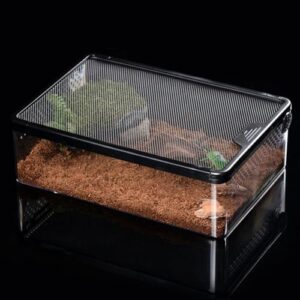
Compact plastic terrarium boxes offer budget-friendly housing for juvenile snakes and small species.
You’ll appreciate their lightweight design and secure locking mechanisms that prevent escapes.
These boxes maintain humidity better than glass tanks, making them suitable for species requiring moderate moisture levels.
However, their limited height restricts use with larger reptiles, and top-only access may stress defensive snakes during handling, which can be a significant stress factor.
Best For: Budget-conscious beginners housing juvenile snakes, small reptile species, or those needing temporary/quarantine enclosures for animals under 3 feet in length.
- Limited height (10cm/3.9 inches) restricts use with larger reptiles and reduces interior furnishing options
- Top-only access may stress defensive snakes during handling and feel threatening to the animals
- Less visually appealing than glass displays with potential need for DIY modifications to enhance habitat complexity
- Cost-effective and lightweight design with secure locking mechanisms that effectively prevent escapes
- Superior humidity retention compared to glass terrariums, ideal for species requiring moderate moisture levels
- Easy to clean, transport, and set up with modular sizing options that accommodate growing animals
8. Large Reptile Enclosure Habitat Tank
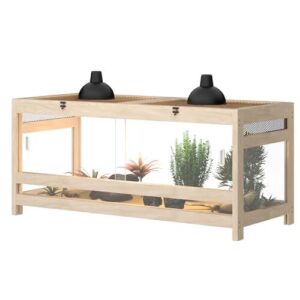
When floor space matters most, large reptile enclosure habitat tanks deliver the real estate your snake needs to thrive.
These spacious 48x24x24-inch tanks provide 8-12 square feet of floor area, perfect for adult ball pythons and corn snakes over four feet long.
You’ll appreciate the dual front access doors that make cleaning and feeding hassle-free, while built-in cable ports accommodate your heating equipment safely.
The reinforced corners and secure locking mechanisms prevent escape attempts from stronger species.
Best For: Snake owners with adult ball pythons, corn snakes, or other medium-to-large species over 4 feet who need spacious floor area and easy maintenance access.
- Provides 8-12 square feet of floor space, exceeding minimum requirements for active snake species
- Dual front access doors enable hassle-free cleaning, feeding, and habitat maintenance
- Built-in cable ports and reinforced construction accommodate heating equipment safely while preventing escapes
- Reports of broken lid panels arriving damaged or breaking during assembly
- Acrylic panels are scratch-prone and require careful handling during setup and cleaning
- Actual dimensions may be slightly smaller than advertised 4x2x2 specifications
9. Reptile Feeding Box Terrarium Cage
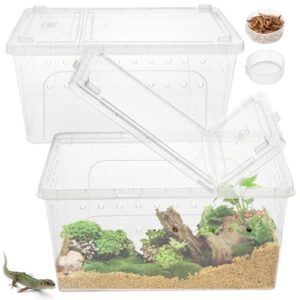
For small snakes requiring separate feeding spaces, these compact boxes offer a practical solution.
You’ll get two 12.6 x 8.7 x 6-inch transparent containers with secure lids and feeding bowls.
The stackable design saves space while providing 360-degree observation during feeding sessions.
However, quality control issues plague recent batches, with some units arriving cracked or missing components.
While functional for juvenile colubrids and quarantine situations, these boxes work best as temporary feeding stations rather than primary housing solutions, due to their limitations and the need for more secure lids in long-term housing.
Best For: Reptile keepers needing temporary feeding spaces for small snakes, juveniles, or quarantine situations where observation and escape prevention are priorities.
- Transparent design provides 360-degree viewing for monitoring feeding behavior and animal health
- Stackable construction saves space while the included feeding bowls enhance functionality for separate feeding routines
- Easy to clean smooth surfaces reduce disease risk and maintenance time between uses
- Quality control issues with recent batches including cracked units and missing components upon delivery
- Limited to small species due to compact 12.6 x 8.7 x 6-inch size, unsuitable for adult or larger reptiles
- Not designed for permanent housing, lacking environmental enrichment and adequate space for long-term use
10. Reptile Breeding Tank Enclosure Cage

Professional breeding tanks offer specialized features that standard terrariums can’t match for serious snake reproduction.
These units include removable partitions to separate breeding pairs safely, secure locking systems preventing escapes during mating, and integrated climate controls maintaining ideal temperature and humidity.
Built from durable glass or acrylic, they’re designed for easy observation and thorough sanitation between breeding cycles.
While not essential for beginners, they’re invaluable if you’re planning future breeding projects, and offer a way to maintain ideal temperature.
Best For: Serious reptile breeders planning snake reproduction projects who need specialized enclosures with climate control and partition features.
- Removable partitions allow safe separation of breeding pairs during mating interactions
- Integrated climate controls maintain precise temperature and humidity levels essential for successful breeding
- Durable glass or acrylic construction enables easy observation and thorough sanitation between breeding cycles
- Significantly more expensive than standard terrariums, making them cost-prohibitive for beginners
- Complex features may be unnecessary for pet owners not planning breeding projects
- Requires more maintenance and monitoring due to specialized climate control systems
Setting Up Enclosures
Once you’ve chosen your snake’s new home, you’ll need to set it up properly to guarantee your pet thrives from day one.
The right combination of substrate, heating, and environmental elements creates a safe haven that mimics your snake’s natural habitat.
Selecting The Right Terrarium Size and Type
Looking beyond basic dimensions, you’ll need to match terrarium materials with your snake’s natural habitat requirements.
Ball python enclosures benefit from PVC construction for superior humidity control, while corn snakes thrive in glass snake terrariums with proper tank ventilation.
Prioritize enclosure security with locking mechanisms, guaranteeing your reptile enclosures maintain stable environmental conditions for ideal beginner reptile care.
When setting up enclosures, consider the importance of proper terrarium sizing to guarantee the health and well-being of your snakes, ensuring a suitable environment through proper tank ventilation.
Creating a Natural Environment With Substrate and Decorations
Creating an environment that mimics your snake’s natural habitat transforms a basic enclosure into a thriving home.
Smart substrate options like aspen or cypress mulch support natural burrowing behaviors while controlling humidity levels effectively. Choosing the right reptile substrate is essential for maintaining a healthy environment.
- Substrate depth: Maintain 2-3 inches for proper digging and scenting behaviors
- Strategic decor placement: Position hides on both warm and cool sides for thermal regulation
- Natural lighting: Use reptile-safe LED systems to establish healthy photoperiods
- Tank landscaping: Add branches and flat rocks for climbing, basking, and shedding assistance
Maintaining Proper Temperature and Humidity Levels
Proper thermal gradients keep your snake comfortable throughout their enclosure. You’ll need heating elements on one side to create warm basking spots while maintaining cooler areas for thermoregulation.
Effective reptile heat management involves using the right reptile heat lamps to achieve ideal temperatures.
| Temperature Zone | Day Range (°F) | Night Range (°F) |
|---|---|---|
| Basking Spot | 88-92 | 78-82 |
| Warm Side | 82-85 | 75-78 |
| Cool Side | 75-78 | 70-75 |
| Ambient Air | 78-80 | 72-75 |
| Water Bowl | 75-78 | 75-78 |
Install thermometers on both sides for accurate monitoring. Under-tank heaters work better than overhead lamps for maintaining consistent warmth.
Humidity levels should stay between 50-60% for most beginner species, achieved through proper ventilation systems and occasional misting.
Maintaining Healthy Enclosures
Once you’ve chosen the perfect beginner enclosure, consistent maintenance keeps your snake healthy and thriving throughout its life.
Regular cleaning schedules, temperature monitoring, and proper feeding create the foundation for successful reptile ownership.
That’ll reward you with years of fascinating companionship.
Daily and Weekly Cleaning Schedules
How often should you clean your snake’s home?
Daily spot-cleaning removes waste and uneaten food, preventing bacterial growth and odors.
Weekly tasks include substrate changes, tank sanitizing with reptile-safe cleaners, and checking hide boxes.
Monthly deep cleaning involves washing all decorations and replacing substrate entirely, which helps with proper enclosure maintenance and humidity control for your snake’s health.
Proper reptile enclosure maintenance involves understanding temperature gradients to create a healthy environment and guarantee proper maintenance.
Monitoring Temperature and Humidity Levels
Accurate snake tank setup demands consistent monitoring with digital thermometers and humidity sensors.
Temperature control systems need thermometer calibration monthly to prevent dangerous fluctuations. Position heat sources carefully while maintaining proper ventilation systems to maintain air quality.
Smart monitoring tools track enclosure maintenance needs, alerting you when reptile tank ideas require environmental adjustments for ideal snake enclosure health, which relies on careful management of the tank’s environment to ensure the well-being of the snakes, making consistent monitoring essential.
Providing a Balanced Diet and Fresh Water
Nutrition excellence starts with understanding your snake’s specific dietary needs and water requirements.
Different species have varying feeding schedules and prey preferences that directly impact their health. Proper snake care involves considering the right snake food options to guarantee a balanced diet.
Here are three essential snake nutrition and hydration tips:
- Food Variety: Offer appropriately-sized frozen-thawed prey every 7-14 days depending on your snake’s age and species
- Water Quality: Provide fresh, dechlorinated water in a heavy bowl that’s changed weekly or when soiled
- Diet Planning: Research your species’ natural prey preferences to promote proper snake nutrition and avoid feeding live prey when possible
Advanced Snake Care
Once you’ve mastered basic snake care, you’ll need to plan for your pet’s long-term needs and understand advanced behaviors.
Advanced care includes providing mental enrichment, managing seasonal cycles like brumation, and making a lifelong commitment to your snake’s well-being.
Planning for Long-Term Snake Care and Commitment
Why commit to decades of snake ownership without understanding the full scope?
Snake habitat requirements change dramatically as your pet grows from juvenile to adult. Commitment levels vary by species – ball pythons live 20-30 years while corn snakes reach 15-20 years.
Owner responsibilities include upgrading snake cages, monitoring snake behavior patterns, and maintaining consistent reptile tank setup standards throughout their lifespan. This is crucial for the well-being of your pet, as neglecting these responsibilities can lead to serious health issues, making owner responsibilities a key aspect of snake care.
Providing Mental Stimulation and Enrichment
Beyond basic shelter, your snake’s mind craves variety to thrive.
Environmental Enrichment through Hide Boxes at different temperatures creates natural choices. Sensory Toys like textured branches boost Snake Agility while exploring.
Mental Stimulation comes from rotating decorations weekly—simple snake habitat ideas that prevent boredom.
Smart reptile tank setup includes multiple levels and hiding spots. These beginner snake care techniques transform basic snake enclosure ideas into dynamic snake housing that keeps your serpent engaged and mentally sharp, using Environmental Enrichment and promoting Mental Stimulation.
Brumation and Hibernation Care for Snakes
Snake Brumation involves natural dormancy periods that many temperate species experience.
Cold Temperature triggers this hibernation-like state, requiring careful Winter Care planning.
Your snake’s enclosure needs specific adjustments:
- Temperature Control: Gradually reduce temps to 50-60°F over several days
- Health Monitoring: Stop feeding 2-4 weeks prior and maintain water access
- Environmental Setup: Guarantee dry substrate and secure reptile habitats during Snake Dormancy
Proper Hibernation Tips support natural cycles while preventing health risks in beginner snake care.
Understanding snake brumation care is vital for a successful brumation period.
Frequently Asked Questions (FAQs)
What type of enclosure is best for snakes?
Before the telegraph revolutionized communication, you’ll want glass tanks for beginners. Twenty-gallon long terrariums work perfectly for juvenile snakes, offering proper ventilation and secure lids that prevent escapes effectively.
Do snakes prefer small enclosures?
No, snakes don’t prefer small enclosures.
They need adequate space to move naturally, thermoregulate, and exercise.
Adult snakes require minimum 36" x 18" enclosures, with larger species needing proportionally bigger spaces for ideal health.
What not to put in a snake enclosure?
Imagine your snake’s home as a carefully balanced ecosystem—don’t clutter it with sharp objects, cedar shavings, heat rocks, or overcrowded décor.
These can cause injuries, respiratory issues, and stress, disrupting your reptile’s natural rhythms.
How do you make a snake enclosure more comfortable?
You’ll want to add proper hiding spots, maintain consistent temperatures using under-tank heating, guarantee adequate humidity levels, provide fresh water regularly, and include appropriate substrate for burrowing behaviors.
Do you need a snake enclosure?
Better safe than sorry—you’ll definitely need a proper enclosure for your snake’s safety and well-being.
A secure habitat prevents escapes, maintains temperature, and creates stress-free conditions essential for healthy reptiles.
What is a DIY snake cage enclosure?
A DIY snake cage involves building your own enclosure using materials like melamine boards, plastic tubs, or wood panels with proper ventilation, heating, and secure latches for cost savings.
How do you make a snake enclosure?
Crafting your own serpent sanctuary involves selecting proper materials like melamine or PVC boards for walls.
You’ll cut panels to size, drill ventilation holes, install heating elements, add secure latches, and waterproof seams for maximum functionality, which includes ensuring proper materials and secure latches.
What kind of enclosure does a beginner snake need?
You’ll need a 20-gallon long glass tank as your starter enclosure. Glass tanks offer excellent visibility while providing secure containment for juvenile and small adult snakes with proper ventilation.
What is the best snake for a first time owner?
Stepping into snake ownership is like entering a gentle maze—you’ll want a forgiving guide.
Ball pythons make excellent first snakes, offering calm temperaments, manageable size, and straightforward care requirements that build your confidence naturally.
What is the best habitat for a pet snake?
You’ll want a glass terrarium as your starting point – they’re budget-friendly and beginner-approved.
Choose a 20-gallon long tank with secure locking lid, proper ventilation, and under-tank heating pad for temperature control.
Conclusion
Research shows that 68% of new snake owners abandon their pets within two years due to improper housing setups.
Selecting the best snake enclosures for beginners requires careful consideration of your species’ specific needs and your experience level.
These ten enclosures offer reliable security features, proper ventilation, and easy maintenance systems that support successful snake keeping.
Remember that your enclosure choice directly impacts your snake’s health and your confidence as a keeper.
Start with quality equipment, maintain consistent environmental conditions, and you’ll create a thriving habitat for years ahead, which is crucial for successful snake keeping.





